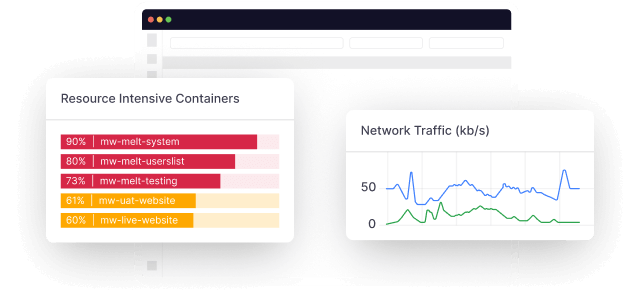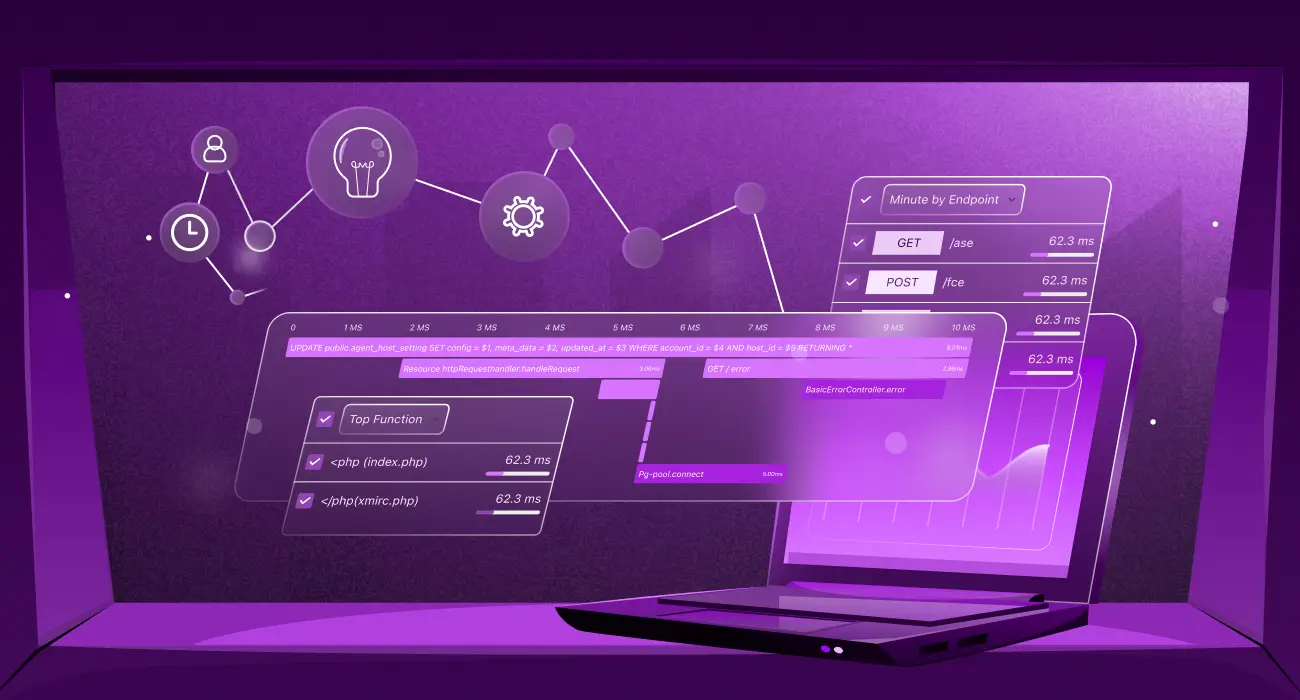It is Black Friday and you have run promotional campaigns that attract a large audience to your application. During peak traffic hours, the application suddenly crashes, causing your firm a wave of lost revenue and frustrated users.
Synthetic testing, if earlier adopted, would have prevented such incidents by simulating user interactions to identify potential performance bottlenecks before they impact real users.
How does synthetic testing work?
1. Synthetic test creation
To implement synthetic testing, you must first determine the key user interactions that need to be tested. This could include user login, form submissions, searches, or any critical business transactions. You then write scripts that emulate these interactions. Also, define the parameters, such as the frequency of tests, geographic locations from which the tests will run, and any specific conditions or variables relevant to the tests.
2. Execution
Execution involves deploying the test scenarios to run at scheduled intervals or continuously from various locations. During execution, various performance metrics (e.g., response times, error rates) are captured and logged.
3. Monitoring
The collected data is analyzed to identify any performance bottlenecks, errors, or downtime. This may involve comparing current performance against historical data or predefined performance benchmarks. If the synthetic tests detect issues such as slow response times, failed transactions, or downtime, alerts can be triggered automatically for notification. Detailed reports are then generated, often in real-time, to provide insights into the application’s performance, trends and patterns.
Types of synthetic tests
Transaction monitoring
This involves simulating specific end-to-end transactions to ensure that critical business processes function correctly. For example, it could monitor the process from user login to purchase confirmation. It helps you track and measure the performance and success of multi-step user interactions, and helps identify where in the transaction chain anomalies might occur.
Availability monitoring
This focuses on checking whether an application is available and accessible to users. It assesses the HTTPS, TCP, DNS, or SSL of the application, and is run at regular intervals from different locations. It helps to ensure that the application is up and running and can be accessed by users at all times.
Performance monitoring
This measures the speed of specific functionalities or pages. Performance tests assess various performance metrics such as load time, response time, and throughput. It identifies bottlenecks and ensures that the application delivers a fast and smooth experience to users.
Benefits of synthetic testing
Synthetic testing offers numerous benefits among which are the following:
1. Proactive performance monitoring
Synthetic testing monitors applications at scheduled intervals or continuously. This enables you to track performance trends over time to detect gradual degradation or improvements, while collecting useful data for immediate action.
2. Improved user experience
Synthetic testing ensures your applications perform consistently well under different conditions. Since real user interactions are simulated, you can better align app performance with users expectations.
3. Faster issue resolution
With synthetic testing, you can collect detailed performance data for analysis and quick resolution of issues. With its comprehensive data and error logs, synthetic testing reduces the time spent troubleshooting as you easily spot the location of issues.
4. Reduced downtime
Regular synthetic tests promptly detect downtime or performance drops. This ensures applications remain accessible and functional, reducing the risk of business disruption due to downtime.
5. Scalability testing
By assessing your application’s ability to handle large volumes of traffic and transactions, synthetic testing informs decisions about infrastructure scaling and capacity planning, ensuring the application can handle peak loads. It also identifies potential points of failure under extreme conditions, enabling preparation and mitigation.
6. Regression testing
Regression testing is a subnet of synthetic testing. When you implement synthetic testing, updates, patches, or new codes and features do not break existing functionality. Knowing that new changes have been tested and verified for any unintended side effects gives you confidence in the deployment process.
Synthetic testing in the development lifecycle
Synthetic testing, when integrated within the developmental cycle, ensures the quality of software systems throughout the development lifecycle. Below are key areas it should be considered for optimum performance.
Shift-left testing
This is the practice of testing earlier in the development lifecycle, rather than waiting until the end stages. By integrating synthetic testing early, you’ll address issues sooner, leading to a more robust and error-free product. Early feedback loop helps you catch defects almost in real-time, and reduces the cost and effort required to fix them later in the cycle.
Continuous integration and continuous deployment (CI/CD)
In CI, code changes are frequently merged into a shared repository, triggering automated builds and tests. Synthetic tests are executed as part of these automated test suites to ensure that each integration maintains the quality and stability of the codebase.
In CD pipelines where the release of code to production environments is automated, synthetic tests simulate end-user interactions and monitor application performance in a live environment.
By continually verifying the application’s behavior in real-world scenarios, synthetic testing ensures that CI/CD deployments are smooth, reliable, and meet performance expectations.
Top 5 advanced synthetic testing techniques
1. API monitoring
APIs, as the backbone of your applications, enable communication between different services and components. They handle critical data transactions and business logic. Monitoring APIs therefore ensures that they respond quickly and correctly, preventing failures that could affect the entire application. Synthetic tests are programmed to make regular API calls, checking for correct responses, response times, and error rates. They also validate data integrity and correctness in the responses.
2. Multi-step transactions
User journeys within an application often involve multiple steps and interactions, such as logging in, searching for a product, adding it to a cart, and checking out. Multi-Step transactions simulate complex user journeys that involve multiple interactions.
Simulating these journeys helps identify issues in the workflow that might not be apparent with isolated tests. To implement this, synthetic testing creates scenarios that string together multiple actions in a sequence to test the flow and logic of the application, track session state, and manage cookies.
3. Mobile app testing
Mobile app testing ensures that applications perform seamlessly across different devices and operating systems. It involves using automated scripts or tools to simulate user interactions with a mobile application. This type of testing is typically performed in a controlled environment to mimic real-world usage scenarios and identify potential issues or bottlenecks in the app’s performance.
4. Stress testing
Stress testing evaluates an application’s behavior under high-load conditions to determine its scalability and breaking points. This test helps you prevent failures during traffic spikes, such as during sales events or viral trends. While executing this technique, you have to measure key metrics such as response times, throughput, error rates, and resource usage under stress.
5. Security Testing
Security testing identifies vulnerabilities and potential security breaches, ensuring the application can withstand malicious attacks. To implement this technique, you’ll have to simulate various attack vectors, such as SQL injection, cross-site scripting (XSS), and man-in-the-middle (MITM) attacks.
Regularly perform penetration testing and vulnerability scanning as part of the synthetic testing suite. A right synthetic testing tool will automate security testing, provide continuous surveillance and early warnings of issues.
Choosing the right synthetic testing tool
The following are key features to consider when selecting a synthetic testing tool for your application:
Ease of use & scripting capabilities
The tool should be user-friendly and easy to set up, even for those with limited technical expertise. It must have a clean, intuitive interface that simplifies the creation and management of tests. The tool should also have robust and flexible scripting capabilities, with support for multiple scripting languages, like JavaScript or Python, and offering visual scripting options for non-coders.
Scenario design and management tools
Your chosen synthetic testing tool must possess the ability to design complex user scenarios and manage them efficiently. It must offer support for creating detailed, multi-step user journeys, and organizing, modifying, and reusing scenarios across different testing contexts. This includes support for versioning test scenarios to track changes and roll back if needed.
With Middleware, you can design detailed multi-step transactions and user journeys.
Geographic distribution of test agents
The tool should have a global reach and offer testing from different geographic locations to simulate a global user base and understand performance variations. It should provide you with the flexibility to choose specific locations close to your actual user base, and the capability to simulate different network conditions, such as latency and bandwidth constraints, from various locations.
Monitoring capabilities & performance metrics
Your chosen synthetic testing tool must possess monitoring capabilities in real time. It should track various performance metrics like response times, load times, uptime, error rates, and more. Middleware offers comprehensive monitoring features for insights into availability, response times, and user experience metrics. It captures detailed performance metrics and visualizes them through its customizable dashboards and reports.
Reporting & alerting functionality
The tool must have effective reporting and alerting mechanisms that generate detailed, customizable reports to inform you about performance issues and trends. The alert should be instant and in real-time via email, SMS, or integrated messaging platforms for critical issues.
Integration with existing monitoring tools
The tool should also integrate seamlessly with existing monitoring and IT tools to provide a unified view of application performance. It should provide support for APIs and webhooks for easy integration with other tools for monitoring, and incident management.
Scalability and pricing models
It should be capable of handling an increasing number of tests and complexity as your application grows. Middleware’s cloud-based architecture ensures effortless scaling, whether you’re running a few tests or thousands, and supports high-load scenarios to simulate real-world conditions.
The tool should also offer transparent and flexible pricing models that can cater to different sizes of organizations, from startups to enterprises. With Middleware, you have trial periods among other multiple pricing tiers, including pay-as-you-go options and subscription-based plans.
Practical applications and use cases
Synthetic testing is applicable across various industries to test the reliability and availability of critical applications:
E-commerce
E-commerce platforms require seamless user experiences, especially during high-stakes interactions such as checkout processes, product searches, and payment processing. Synthetic testing helps simulate user actions during the entire checkout process, including adding items to the cart, entering shipping details, applying discounts, and making payments. It integrates with payment gateways to ensure transactions are processed swiftly and securely. With synthetic testing, you can also monitor the performance of promotional campaigns, especially during high-traffic events.
Financial services
Financial institutions rely heavily on online services for transactions, account management, loan applications, and more. Ensuring these services are reliable and performant is vital for customer trust and regulatory compliance. Synthetic testing simulates user logins to verify the speed and security of the authentication process. It tests the functionality and performance of inter-account transfers and international remittances, and validates the performance of viewing detailed transaction histories and statements.
Healthcare
Healthcare applications, including electronic health records (EHR), patient portals, and telemedicine services, require high reliability due to the delicate nature of health data and services. Synthetic testing helps to simulate user interactions with patient portals to ensure that patients can access their records, book appointments, and review test results without issues. It also monitors the EHR Systems to validate fast retrieval and updating of patient records. It ensures that telemedicine platforms, including video consultations and online prescription services, are functioning properly.
Best practices for implementing synthetic testing
To ensure your synthetic testing exercise delivers useful insights and value, you need to consider the following key best practices:
1. Script management
To maintain and update your synthetic test scripts, the following tips are instructive:
- Use a clear and consistent naming convention for scripts to make them easy to find, understand, and manage.
- Employ a version control system to track changes and roll back to previous versions if needed.
- Write modular scripts that can be reused across different tests to reduce redundancy and simplify updates.
- Review and update scripts regularly to keep them aligned with current application functionality and performance standards.
- Maintain comprehensive documentation for each script, explaining what it tests, the expected results, and any dependencies.
- Integrate automated testing for the scripts themselves.
2. Test scheduling and frequency
The following are guidelines on how often to run synthetic tests and schedule them:
- Identify critical user paths and business transactions, and prioritize frequent testing for these scenarios.
- Run baseline tests at regular intervals–hourly or daily, to establish normal performance metrics and detect deviations quickly.
- Increase the frequency of testing during high-traffic and critical events–marketing campaigns, product launches, to ensure application stability.
- Schedule tests to run from multiple geographic locations and at different times to capture varying user experiences and potential location-specific issues.
- Strike a balance between test frequency and resource usage. Overly frequent testing can consume excessive resources, while infrequent testing might miss critical issues.
- For certain types of tests, randomize the intervals to mimic real user behavior more closely and prevent predictable testing patterns.
3. Data analysis and reporting
The following are best practices for generating actionable insights and analysing test results:
- Define and prioritize key performance indicators (KPIs) such as response times, error rates, and uptime. Align these KPIs with business objectives.
- Utilize tools and scripts to automatically analyze test results, flag anomalies, and reduce the burden of manual data review.
- Compare current test results with historical data to identify performance trends, recurring issues, and the impact of changes over time.
- When anomalies or issues are detected, conduct a root cause analysis to understand the underlying factors and devise effective solutions.
- Use and customise dashboards to present relevant-only data in an easy-to-understand format.
- Generate regular, scheduled reports that summarize findings, trends, and recommendations.
- Focus on providing actionable insights rather than just raw data. Highlight areas of concern, suggest possible improvements, and track the implementation and impact of these recommendations.
- Use the findings from synthetic testing to continuously improve application performance, user experience, and overall system reliability. This includes refining testing strategies, updating scripts, and addressing identified issues promptly.
Future trends in synthetic testing
As technology continues to evolve, synthetic testing is bound to evolve along and experience advancements, especially in the areas of Artificial Intelligence (AI), Machine Learning (ML), Automation, and DevOps.
AI and machine learning
AI has the intelligence to analyze user interactions and behavior to generate synthetic test scripts that mirror real user actions more closely. In addition, Machine learning algorithms can predict potential performance issues by analyzing historical data and identifying patterns. AI and ML-driven synthetic testing models enhance the detection of subtle anomalies and performance regressions that traditional methods might miss. They can differentiate between normal variations and actual issues.
AI-driven synthetic testing will optimize test scheduling by analyzing usage patterns and traffic data to determine the most effective times to run tests. It will also assist in creating smarter reports by summarizing vast amounts of data, highlighting critical insights, and providing actionable recommendations. We therefore tend to experience even more precise and realistic testing scenarios, reduced manual effort and faster test execution.
Automation and DevOps
Synthetic testing is increasingly being automated in line with Infrastructure-as-Code (IaC) practices, where test environments are provisioned and managed through code. Automation empowers synthetic testing tools to initiate corrective actions when synthetic tests detect failures, leading to self-healing systems that maintain performance with minimal human intervention. This also enables orchestration tools to automatically manage test execution, data collection, and reporting within CI/CD pipelines, which streamlines the entire synthetic testing workflow.
There will be enhanced integration with DevOps tools to promote better collaboration between development and operations. This will provide you with the visibility and insights needed to continuously improve software quality. Automation in synthetic testing is also extending into the realm of security, where new codes are not only performant but also secure. This aligns with the DevSecOps philosophy of integrating security testing early and often.
Conclusion
Synthetic testing is a proactive approach to ensuring the reliability and user satisfaction of applications across various industries. It is not just about finding issues; it’s about ensuring your application delivers the best possible experience to your users and meets your business goals.
To have the best experience, it is critical to choose the right tool like Middleware. It offers synthetic testing within its observability functionalities, and incorporates AI, machine learning, and deep automation capabilities.
When you choose Middleware, you do not only choose a tool that offers robust synthetic testing capabilities, but one that also integrates seamlessly into your existing workflows.




